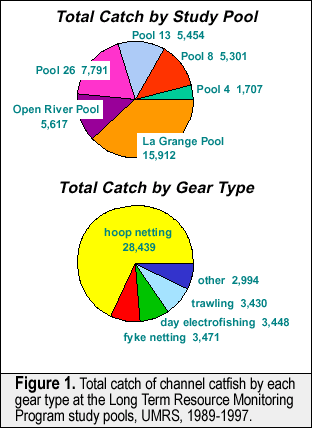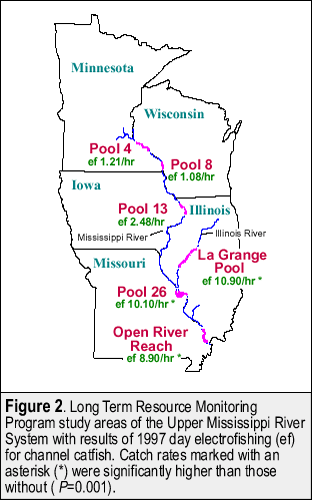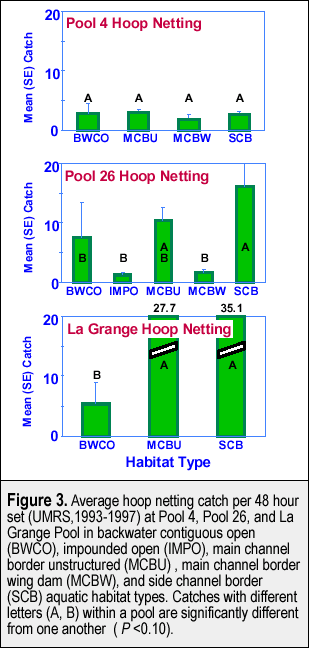|
One application of Long Term Resource Monitoring
Program (LTRMP) data is to evaluate long term trends in channel
catfish (Ictalurus punctatus Rafinesque 1818) populations.
This species is an important component of the Upper Mississippi
River System (UMRS) fish community because it is numerically abundant,
it comprises a significant portion of the total fish biomass, and
it is avidly sought by both sport anglers and commercial harvesters.
Since 1989, biologists at the LTRMP
Field Stations have monitored fish population and community
structure at six pools and in multiple aquatic habitat types of
the UMRS. These pools include the tailwater, impounded, side channel,
main channel, and backwater habitats defined by navigation lock
and dam 4, 8, 13, and 26 of the Mississippi River;  the
“Open” Mississippi River near Cape Girardeau, Missouri;
and La Grange Pool of the Illinois River near Havana, Illinois.
Both Pool 26 (at Alton, Illinois) and La Grange Pool Field Stations
are operated by the Illinois
Natural History Survey (INHS). the
“Open” Mississippi River near Cape Girardeau, Missouri;
and La Grange Pool of the Illinois River near Havana, Illinois.
Both Pool 26 (at Alton, Illinois) and La Grange Pool Field Stations
are operated by the Illinois
Natural History Survey (INHS).
Because certain gears are known to be selective for certain sizes
and/or species of fish, LTRMP staff use several different gears
for community and population assessment, including day and night
electrofishing, small and large hoop netting, fyke netting (standard,
tandem, and mini), seining, and trawling. The gears that capture
the most channel catfish are hoop nets (small and large), accounting
for 68.1% of the total catch. Fyke netting, day electrofishing,
and trawling account for 8.3%, 8.3%, and 8.2% of the total channel
catfish catch, respectively.
A combined total of over 42,000 channel catfish have been captured,
measured, and returned to the UMRS by LTRMP fish biologists. There
is a striking variability in the catch (and presumably abundance)
of channel catfish from one pool to another and usually among habitat
types within a pool (Figure 1). The La Grange Pool yielded the largest
share of the combined catch (15,912 fish or 38.1%) while Pool 4,
along the Minnesota portion of the Upper Mississippi River, yielded
the least (1,707 fish or 4.1%).  We
noticed a strong south to north gradient in day electrofishing catch
rates. During nearly all years, the catch rates were significantly
higher at Pool 26, Open River Reach, and La Grange Pool than at
Pools 4, 8, and 13. Catches by electrofishing ranged from over 10
channel catfish per hour at La Grange Pool in 1997 to less than
1 per hour at Pool 4 in 1994 (Figure 2). In 1993, we experienced
low catch rates at most of our study pools due in part to high water
conditions of the great flood. However, a tremendous number of channel
catfish were collected at Pool 26 (over 26 fish were collected per
hour by day electrofishing) on the Mississippi River that year. We
noticed a strong south to north gradient in day electrofishing catch
rates. During nearly all years, the catch rates were significantly
higher at Pool 26, Open River Reach, and La Grange Pool than at
Pools 4, 8, and 13. Catches by electrofishing ranged from over 10
channel catfish per hour at La Grange Pool in 1997 to less than
1 per hour at Pool 4 in 1994 (Figure 2). In 1993, we experienced
low catch rates at most of our study pools due in part to high water
conditions of the great flood. However, a tremendous number of channel
catfish were collected at Pool 26 (over 26 fish were collected per
hour by day electrofishing) on the Mississippi River that year.
The total number of channel catfish caught from each habitat type
also varied. As one might infer from their name, we caught far more
channel catfish in side channel border and main channel border unstructured
habitats (33.1% and 36.7% of the total catch, respectively) than
in all other habitat types combined. These habitats often provide
snags, root cavities and other woody debris with moderate flows
required by channel catfish. Only 7.6% and 2.7% of the total catch
of channel catfish were taken in backwater and impounded habitats,
respectively. Catch rates by hoop nets (Figure 3) were significantly
higher in main channel and side channel habitats than in backwater
or impounded habitats at Pools 8, 13, 26; Open River Reach; and
La Grange Pool (P<0.10). However, we found no difference
in catches by hoop nets among main channel, side channel, and backwater
habitats at Pool 4. Our low catches overall at this pool may explain
this lack of distinction.  The
highest hoop net catches were in main channel border unstructured
and side channel border habitats at La Grange Pool of the Illinois
River, where catches per 48-hr hoop net sets (one small and one
large hoop net) averaged 28 and 35 channel catfish per set, respectively. The
highest hoop net catches were in main channel border unstructured
and side channel border habitats at La Grange Pool of the Illinois
River, where catches per 48-hr hoop net sets (one small and one
large hoop net) averaged 28 and 35 channel catfish per set, respectively.
Length frequency distributions within study pools were highly variable
among years. However, we noticed excellent recruitment of channel
catfish in 1991 at nearly all pools of the UMRS. This was likely
due to a relatively smooth annual flood pulse in 1991 which provided
channel catfish excellent spawning opportunities. The strength of
this cohort was evident in subsequent years, particularly at Pool
8, as lengths increased from <10 cm in 1991 to >40 cm in 1997.
Although our catches of age-0 fish were high at Pool 26, Open River
Reach, and La Grange Pool throughout the 1990s, we caught few age-0
channel catfish during 1992-1997 at Pool 13 and Pool 4. Age-0 channel
catfish at Pool 8 were rarely collected during these years. Low
catches of small channel catfish in UMRS pools may be partially
due to reduced gear efficiency in clear waters with abundant submergent
vegetation. Also, trawling was used extensively prior to 1993 (1132
hauls) and was most effective in capturing age-0 channel catfish
in 1991; unfortunately, use of trawling was reduced during 1993-1997
which may explain, to some extent, our low catches of small channel
catfish at Pools 4, 8, and 13.
We documented high spatial and temporal variability in abundance
as well as in size distributions of channel catfish. Some of this
variability is likely a true reflection of actual fluctuations occurring
in these channel catfish populations. However, some of this variability
is likely due to differences in the efficiency of our gears among
pools and habitat types of the UMRS, as well as among years with
variable annual hydrological regimes within each of our study pools.
Regardless, there is evidence that years with a high, smooth spring
flood pulse that mimics a “natural flow regime” have been
beneficial for recruitment of channel catfish. Further research
should consider more closely the specific relationships between
channel catfish year class strength and hydrological parameters
such as flood magnitude, timing, duration, and frequency.
|


 the
“Open” Mississippi River near Cape Girardeau, Missouri;
and La Grange Pool of the Illinois River near Havana, Illinois.
Both Pool 26 (at Alton, Illinois) and La Grange Pool Field Stations
are operated by the
the
“Open” Mississippi River near Cape Girardeau, Missouri;
and La Grange Pool of the Illinois River near Havana, Illinois.
Both Pool 26 (at Alton, Illinois) and La Grange Pool Field Stations
are operated by the  We
noticed a strong south to north gradient in day electrofishing catch
rates. During nearly all years, the catch rates were significantly
higher at Pool 26, Open River Reach, and La Grange Pool than at
Pools 4, 8, and 13. Catches by electrofishing ranged from over 10
channel catfish per hour at La Grange Pool in 1997 to less than
1 per hour at Pool 4 in 1994 (Figure 2). In 1993, we experienced
low catch rates at most of our study pools due in part to high water
conditions of the great flood. However, a tremendous number of channel
catfish were collected at Pool 26 (over 26 fish were collected per
hour by day electrofishing) on the Mississippi River that year.
We
noticed a strong south to north gradient in day electrofishing catch
rates. During nearly all years, the catch rates were significantly
higher at Pool 26, Open River Reach, and La Grange Pool than at
Pools 4, 8, and 13. Catches by electrofishing ranged from over 10
channel catfish per hour at La Grange Pool in 1997 to less than
1 per hour at Pool 4 in 1994 (Figure 2). In 1993, we experienced
low catch rates at most of our study pools due in part to high water
conditions of the great flood. However, a tremendous number of channel
catfish were collected at Pool 26 (over 26 fish were collected per
hour by day electrofishing) on the Mississippi River that year. The
highest hoop net catches were in main channel border unstructured
and side channel border habitats at La Grange Pool of the Illinois
River, where catches per 48-hr hoop net sets (one small and one
large hoop net) averaged 28 and 35 channel catfish per set, respectively.
The
highest hoop net catches were in main channel border unstructured
and side channel border habitats at La Grange Pool of the Illinois
River, where catches per 48-hr hoop net sets (one small and one
large hoop net) averaged 28 and 35 channel catfish per set, respectively.